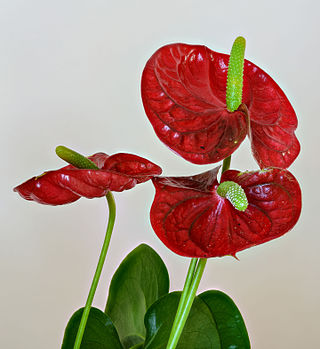
Anthurium is a genus of about 1,000 species of flowering plants, the largest genus of the arum family, Araceae. General common names include anthurium, tailflower, flamingo flower, pigtail plant, and laceleaf.
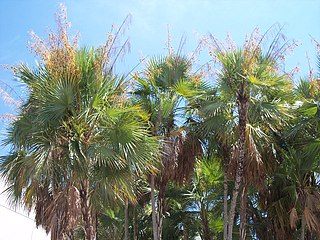
Acoelorraphe is a genus of palms with a single species Acoelorraphe wrightii, known as the Paurotis palm, Everglades palm or Madeira palm in English and cubas, tique, and papta in Spanish. The genus name is sometimes spelt as Acoelorrhaphe or Acoelorhaphe, which are treated by orthographical variants by the International Plant Names Index.

Allium stellatum, commonly known as the autumn onion, prairie onion, cliff onion, or glade onion, is a North American species of wild onion in the Amaryllidaceae family that is native to central Canada and the central United States.
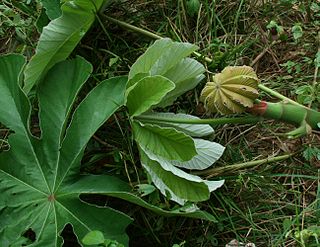
Cecropia peltata is a fast-growing tree in the genus Cecropia. Common names include trumpet tree, trumpet-bush, bacano, bois canon and snakewood. It is listed as one of the world's 100 worst invasive alien species.
Thomas Bernard Croat is an American botanist and plant collector, noteworthy as one of botanical history's "most prolific plant collectors". He has collected and described numerous species of plants, particularly in the family Araceae, in his career at the Missouri Botanical Garden.
Cyananthus formusus is a species of perennial flowering plant in the family Campanulaceae. It is native to grassy slopes and forests of northwest Yunnan in China. In Mandarin the species is known as 美丽蓝钟花. Originally described by Ludwig Diels in 1912 in the Notes of the Royal Botanical Garden Edinburgh, the species is a small, blue-flowered plant suitable for Alpine gardens.

Anthurium cubense is a species of flowering plant in the family Araceae, native to southeastern Mexico, Central America, Cuba, Colombia, and Venezuela. A large species, it is occasionally kept as a hothouse specimen or as a house plant. With Anthurium pendulifolium, it is a parent of the 'Big Bill' hybrid cultivar, with leaves exceeding 10 ft (3 m).
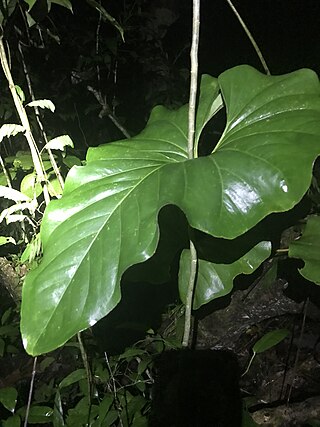
Anthurium brownii is a species of plant in the genus Anthurium native to Central and South America, from Costa Rica through Panamá, and south to Colombia, Ecuador, and Venezuela. First scientifically described in 1876, it was collected by Gustav Wallis and named for N. E. Brown. A. brownii grows from sea level up to 1,200 meters (3,900 ft) in tropical forests.

Anthurium clidemioides is a species of plant in the genus Anthurium native to Costa Rica, Panama, and Colombia. One of the more distinctive Anthuriums, it is a vining climber with almost stalkless, bullate leaves that can range from light to very dark green. Along with Anthurium flexile it is one of only two species in the genus that produces roots between nodes.
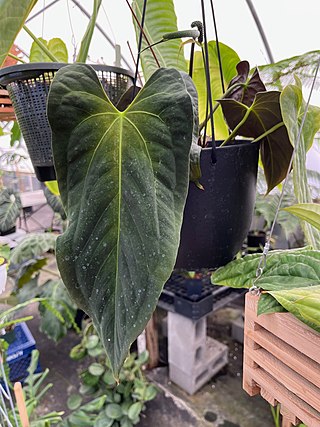
Anthurium papillilaminum is a species of plant in the genus Anthurium native to Panama. A. papillilaminum grows terrestrially and has very dark green cordate leaves on short stems. Its native range is very limited, with the species endemic to only the coasts of Colón Province and Darién Province up to 100 meters (330 ft) above sea level. A member of the section Cardiolonchium, it is closely related to other velvet-leaved Anthuriums, though it does not have silver veins on the leaves like Anthurium crystallinum.

Anthurium corrugatum is a species of plant in the genus Anthurium native to Central and South America from Panama to Ecuador. This species is noted for its cordate leaves with a network of fine veins that gives it a bullate appearance. A terrestrial grower, it is adapted to cool, humid climates. It is a member of the section Polyneurium along with Anthurium argyrostachyum and others.
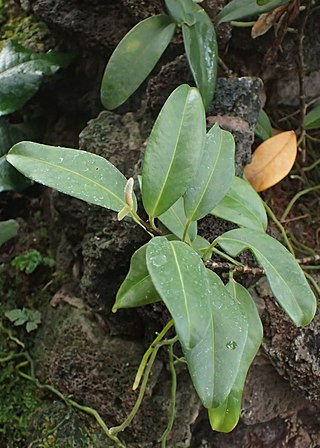
Anthurium scandens is a species of plant in the genus Anthurium. Native from Mexico to Southeast Brazil, it is the most widely distributed species of Anthurium in the Americas, and also extends to the Caribbean including Haiti, Puerto Rico, Jamaica, and other nations.

Anthurium clavigerum is a species of plant in the genus Anthurium. Native to Central and South America, it ranges from Honduras to central and western Brazil. This epiphyte has distinctive leaves that are deeply lobed and sometimes sinuous edges. The main stem can be several meters long and the palmate leaves can be 2 meters across, giving it the largest foliage of any Anthurium in Central America.

Anthurium podophyllum is a species of plant in the genus Anthurium native to coastal areas of the Mexican states of Veracruz and Oaxaca. A terrestrial species, it grows in tropical forest understories in seasonally dry areas. It is named for its palmate leaves that somewhat resemble plants in the (unrelated) genus Podophyllum, and which have many subdivisions. It is related to other terrestrial Anthurium with similar leaf morphology in the section Schizoplacium, such as Anthurium pedoradiatum, and produces orange berries.

Anthurium microspadix is a species of plant in the genus Anthurium. Growing as an epiphyte or a terrestrial shrub, it is native from the southern Mexican states of Oaxaca and Chiapas to Bolivia from 800–2,300 metres (2,600–7,500 ft) in elevation. One of the more widely distributed and variable species in its genus, it is easily confused with species such as Anthurium pallens and others.
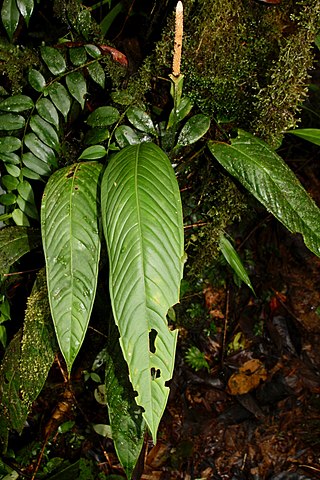
Anthurium pallens is a species of plant in the genus Anthurium. Growing as a climbing epiphyte with short stems and usually pendent growth, it is native to Central America. Easily confused with other species such as Anthurium microspadix, it can be distinguished by its typically shorter branches and leaf blades acute to rounded at the base.

Anthurium dwyeri is a species of plant in the genus Anthurium native from Costa Rica to the Chocó Department of Colombia. Named in honor of the botanist Dr John D. Dwyer, it has no known close relatives but is a member of the section Porphyrochitonium. An epiphyte, it is most easily recognizable by its leathery, oblong to elliptical leaves that are 24–40 centimetres (9.4–15.7 in) long and grow on triangular stems.

Anthurium obtusum is a species of plant in the genus Anthurium widely distributed in Central and South America, from Belize to Bolivia. The species was originally described as Anthurium trinerve by Adolf Engler and then in 1997, reclassified. The species is easily confused with Anthurium scandens, but can be distinguished by its terrestrial growth habit and a white spathe which stays erect rather than reflexed.

Anthurium wendlingeri is a species of aroid plant, in the genus Anthurium, found from Central to South America, from SE Nicaragua to NW Colombia. It grows in moist, montane tropical habitats as an epiphyte. Unique among its genus, A. wendlingeri has long, pendant and strap-like leaves, and can have a slightly velvety appearance.
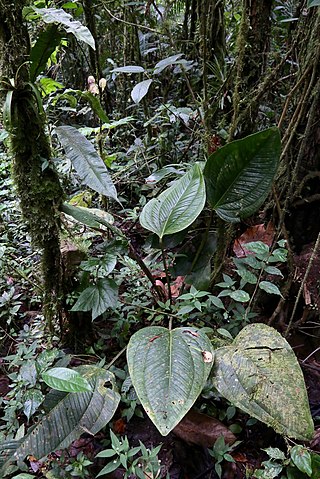
Anthurium ovatifolium is a species of plant in the genus Anthurium native to Colombia, Ecuador, and Peru. It grows in wet tropical habitats, and is a member of the section Digitinervium. Its species name refers to the oval shape of its leaves, and it can be distinguished from similar species like Anthurium lentii by its red berries.


















